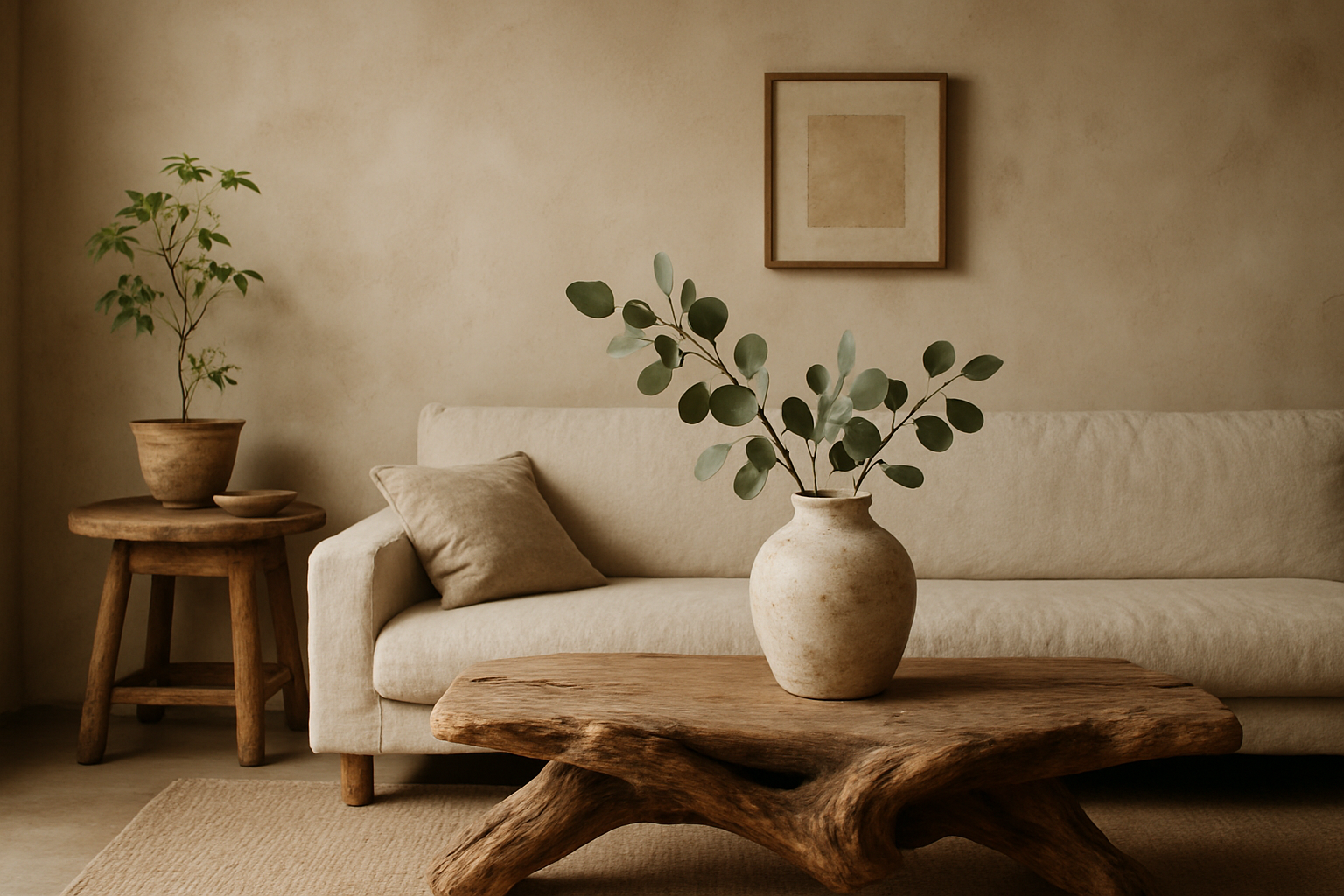Whimsical Wabi-Sabi: Embracing Imperfection in Home Design
In a world obsessed with perfection, a new design philosophy is taking root in American homes, offering a refreshing counterpoint to polished interiors and immaculate spaces. Whimsical Wabi-Sabi, a playful twist on the traditional Japanese aesthetic, is capturing the hearts of homeowners and designers alike. This innovative approach marries the serene acceptance of imperfection with a dash of whimsy, creating spaces that are both soulful and spirited.

The Roots of Wabi-Sabi
Wabi-Sabi is an ancient Japanese philosophy that finds beauty in imperfection and transience. It originated from Buddhist teachings, particularly the concept of the three marks of existence: impermanence, suffering, and absence of self-nature. Over time, this worldview seeped into Japanese aesthetics, influencing art, architecture, and design.
Traditionally, Wabi-Sabi manifests in simple, rustic elegance. It values natural materials, subtle textures, and muted color palettes. The aesthetic often incorporates weathered or aged items, celebrating the patina that comes with time and use. In its purest form, Wabi-Sabi encourages a minimalist approach, favoring simplicity and authenticity over ornate decoration.
The Whimsical Twist
The Whimsical Wabi-Sabi trend takes the core principles of Wabi-Sabi and injects them with a dose of playfulness and color. This new interpretation maintains the appreciation for imperfection and natural beauty but adds elements of surprise, humor, and personal expression.
Where traditional Wabi-Sabi might feature a lone, asymmetrical flower arrangement in a rough-hewn vase, Whimsical Wabi-Sabi might pair that vase with a collection of colorful, hand-blown glass objects. The result is a space that feels both grounded and lighthearted, honoring the passage of time while celebrating the joy of the present moment.
Key Elements of Whimsical Wabi-Sabi
To incorporate Whimsical Wabi-Sabi into your home, consider the following elements:
-
Embrace imperfection: Look for pieces with character – furniture with visible knots or grain, textiles with slight variations in weave, or ceramics with deliberate irregularities.
-
Mix old and new: Combine vintage finds with contemporary pieces. An antique wooden chest might sit alongside a modern, sculptural lamp.
-
Play with color: While traditional Wabi-Sabi leans towards earthy tones, the whimsical version welcomes pops of vibrant color. Think a worn leather armchair adorned with a bright, patterned throw pillow.
-
Incorporate natural elements: Bring the outdoors in with potted plants, driftwood sculptures, or collections of interesting stones or shells.
-
Add unexpected touches: This is where the whimsy comes in. A serious antique mirror might be paired with a funky, modern frame, or a sleek dining table could be surrounded by mismatched, colorful chairs.
The Art of Curated Clutter
One of the most distinctive features of Whimsical Wabi-Sabi is its approach to displaying objects. Unlike the stark minimalism often associated with traditional Wabi-Sabi, this new style embraces a form of curated clutter. The key is to create vignettes that tell a story and reflect the personality of the inhabitants.
Start by selecting items that have personal meaning or aesthetic appeal. This could include family heirlooms, travel souvenirs, or handmade crafts. Arrange these objects in small groupings, playing with height, texture, and color. The goal is to create a sense of organized chaos – a collection that feels both intentional and organic.
Remember, the beauty of Whimsical Wabi-Sabi lies in its imperfection. Don’t be afraid to mix styles, eras, or materials. A sleek modernist sculpture might find a home next to a weathered piece of driftwood and a child’s finger painting. The juxtaposition of these elements creates visual interest and invites contemplation.
DIY and Upcycling in Whimsical Wabi-Sabi
The Whimsical Wabi-Sabi aesthetic lends itself beautifully to DIY projects and upcycling. This approach not only aligns with the philosophy’s emphasis on imperfection and authenticity but also promotes sustainability – a growing concern in home design.
Consider transforming old furniture pieces with colorful paint or decoupage. A weathered dresser could become a statement piece with a coat of vibrant turquoise paint and mismatched knobs. Or, create a unique wall hanging by weaving together scraps of fabric, incorporating different textures and patterns.
Upcycling projects are particularly suited to this style. Old wooden crates can be stacked to create rustic shelving units. Vintage suitcases might become quirky side tables. Even broken ceramics can find new life through the Japanese art of kintsugi, where cracks are repaired with gold, silver, or platinum lacquer, turning imperfections into beautiful features.
Whimsical Wabi-Sabi in Different Rooms
While Whimsical Wabi-Sabi can be applied throughout the home, it can take on different characteristics in various spaces:
In the living room, create a cozy, eclectic atmosphere with a mix of textures and patterns. A well-worn leather sofa might be paired with colorful, handwoven throw blankets and an array of mismatched cushions. Display collections of books, art, and objects on open shelving, allowing each piece to tell its own story.
In the kitchen, embrace the beauty of use. Display well-loved cookware and utensils rather than hiding them away. Mix vintage and modern pieces – perhaps a sleek, contemporary faucet alongside a collection of hand-thrown ceramic mugs. Consider open shelving to showcase a collection of mismatched plates and bowls.
In the bedroom, focus on creating a serene yet personalized space. A reclaimed wood headboard might be paired with crisp, white linens and a colorful quilt. Incorporate natural elements like potted plants or a driftwood lamp base. Display personal mementos and artwork that bring joy and inspire relaxation.
The Psychology of Whimsical Wabi-Sabi
Beyond its aesthetic appeal, Whimsical Wabi-Sabi offers psychological benefits. In a world that often demands perfection, this design philosophy provides a refreshing alternative. It encourages us to find beauty in the imperfect, to value experiences over possessions, and to create spaces that truly reflect our personalities and lives.
By surrounding ourselves with objects that have history and character, we create a sense of connection and continuity. The whimsical elements inject joy and playfulness into our daily lives, reminding us not to take ourselves too seriously. This balance of thoughtfulness and lightheartedness can create a home environment that feels both grounding and uplifting.
Moreover, the emphasis on imperfection can be liberating. It takes the pressure off having a “picture-perfect” home and allows for a more relaxed, lived-in atmosphere. This can lead to reduced stress and increased comfort in our living spaces.
Conclusion: The Future of Whimsical Wabi-Sabi
As we move towards more personalized and meaningful interiors, Whimsical Wabi-Sabi offers a compelling vision for the future of home design. It challenges the notion of disposable decor, encouraging us to value items with history and character. At the same time, it injects a sense of fun and individuality into our spaces.
This trend is likely to evolve, potentially incorporating more elements of sustainability and local craftsmanship. We might see an increased focus on natural, biodegradable materials and a revival of traditional crafting techniques, all infused with a spirit of creativity and whimsy.
Ultimately, Whimsical Wabi-Sabi is more than just a design trend – it’s a philosophy for living. It encourages us to find beauty in the imperfect, joy in the everyday, and to create homes that are true reflections of ourselves. In a world that often feels chaotic and unpredictable, this approach to design offers a way to create spaces that are both comforting and inspiring, grounded in tradition yet open to the playful possibilities of the present.





